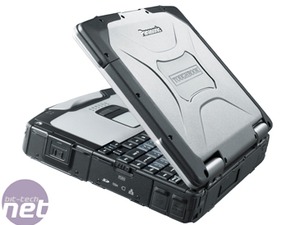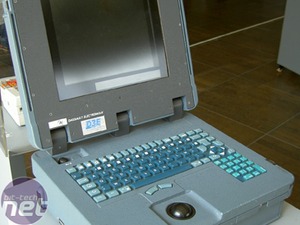
How to toughen up a PC
It's one thing knowing what qualities your PC needs to have to be able to attain an IP Code rating, but another matter to take it from flower power to Jack Bauer. The differences between a Mil-Spec laptop and a standard model start at the most basic level with the casing.Some of Panasonic's Toughbook laptops use magnesium alloy cases, which are much stronger than standard plastic casing. As a tougher casing won't warp or flex too much when it hits the ground after a fall, it will protect more fragile internal components from damage.
This strength is of great benefit but it doesn't completely eliminate the problems of shock damage from a fall. To prevent shock damage, a system needs shock absorbers in much the same way as a car needs suspension - the force of any impact needs to be dissipated before it's transferred to vital components; failing that, vital components need to be braced to handle it.
The toughness of a metal casing is very important, but it isn't the end of the issue for a rugged PC, as they also feature rubber corners to the case to reduce the shock of impact. The effect of this is that rather than landing like a brick and taking all the energy of the impact in one hit, a rugged PC will bounce.
Hard disks are one area in which advances originally developed for rugged technology have made their way into the mainstream. Originally, hard disks had to be manually instructed by the user to 'park' the read heads if the PC was about to be moved, in order to protect the drive from damage. This now happens automatically when the drive powers down, but many laptop hard disks also park the heads when a motion sensor detects the laptop has been dropped. Hard disks can be further protected through the use of a shock-absorbent mounting.
In order to gain a high IP Code and protect against the ingress of liquids, laptop designers need to pay attention to the keyboard, as this frequently covers important system components. Systems ruggedised to an IP Code of 54 or better have sealed keyboards and touchpads. This not only means that spills won't get into the main body of your system, but also that they won't penetrate the workings of your keyboard either. Water is bad enough, but sticky or acidic liquids can corrode connections or leave a residue that causes problems even when dry, so keeping them out is the best idea.


Left: A machine from Panasonic's Toughbook range. Right: The Dassault D3R was an out and out battlefield computer built in 1994, weighing in at a hefty 10kg. Ruggedisation technology and colour schemes have come a long way since.
Rugged laptops often include screens covered by a sealed layer that protects it from scratches and impact as well as rain and dust. These screens are often also geared towards working out doors, which means that unlike regular screens that are close to unreadable in direct sunlight these displays can be viewed anywhere. As well as sealing screens and touchpads, sockets on the outside of the casing have sealable covers and all the screws have gaskets sealing them shut to prevent liquids from getting inside.
One area in which computers are susceptible to dust is their fan vents, but most ruggedised systems with a high IP Code have neither vents nor fans. Cooling methods for ruggedised systems vary, but one of the advantages of metal casing is that it can be incorporated into the cooling system. Heat from the CPU and other hot components is distributed evenly around the casing using heatpipes. Commercial PC manufacturers have experimented with this approach - most notably Zalman, with its passively cooled TNN300 and TNN500 cases. Some netbooks, such as Sony's P-series, also get away with it, thanks to their low-power Atom CPUs.
There are, of course, drawbacks to making a PC tough and electromagnetically secure. The extra care and attention to weak points impacts on price - Panasonic's Toughbook CF-30 is fully ruggedised, meets the latest F revision of the MIL-STD-810 spec and is IP54-compliant. It also costs about £3,380, and its specs are relatively conservative. It has a 1.6GHz Core 2 Duo L7500 CPU, 1GB RAM and a 13.3in 1,024 x 768 screen. While you could buy half a dozen or more similarly performing laptops for the same price, if you used them in tough conditions, they wouldn't last long, and it shows the premium that ruggedised designs can demand. The second drawback of rugged technology is its size and weight - the CF-30 weighs nearly 4kg, and its casing makes it incredibly chunky.

MSI MPG Velox 100R Chassis Review
October 14 2021 | 15:04








Want to comment? Please log in.